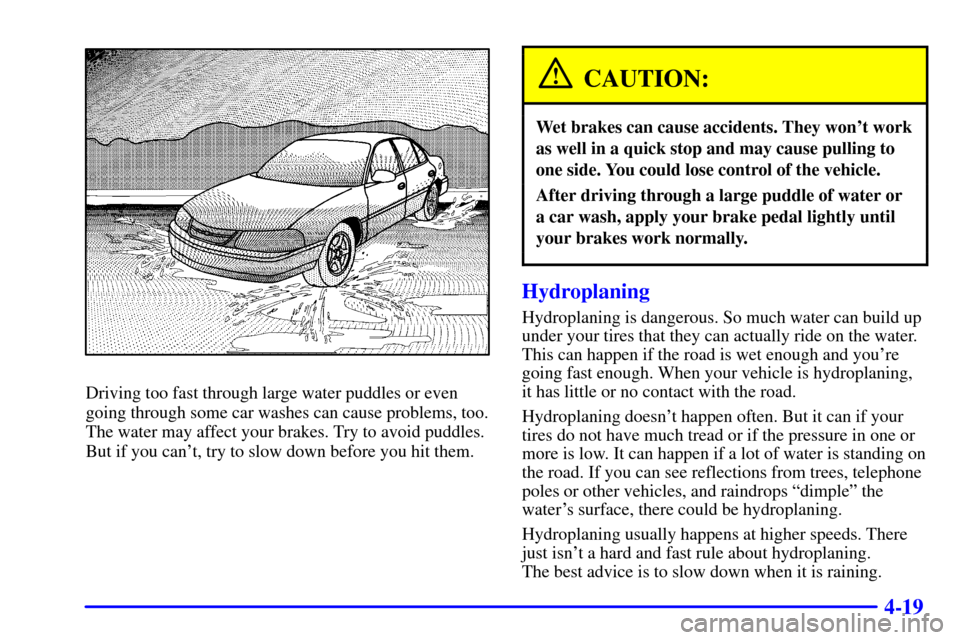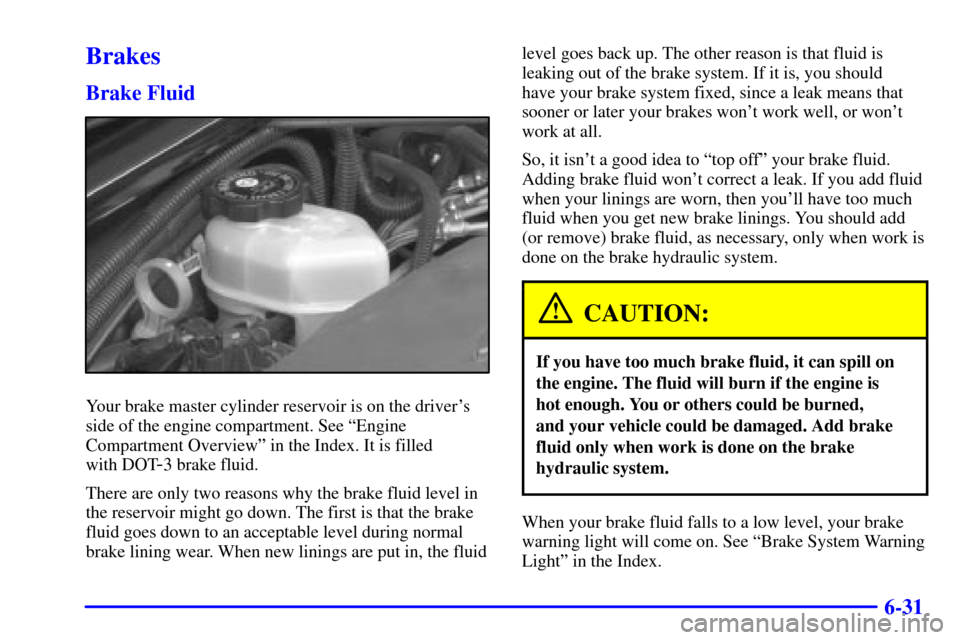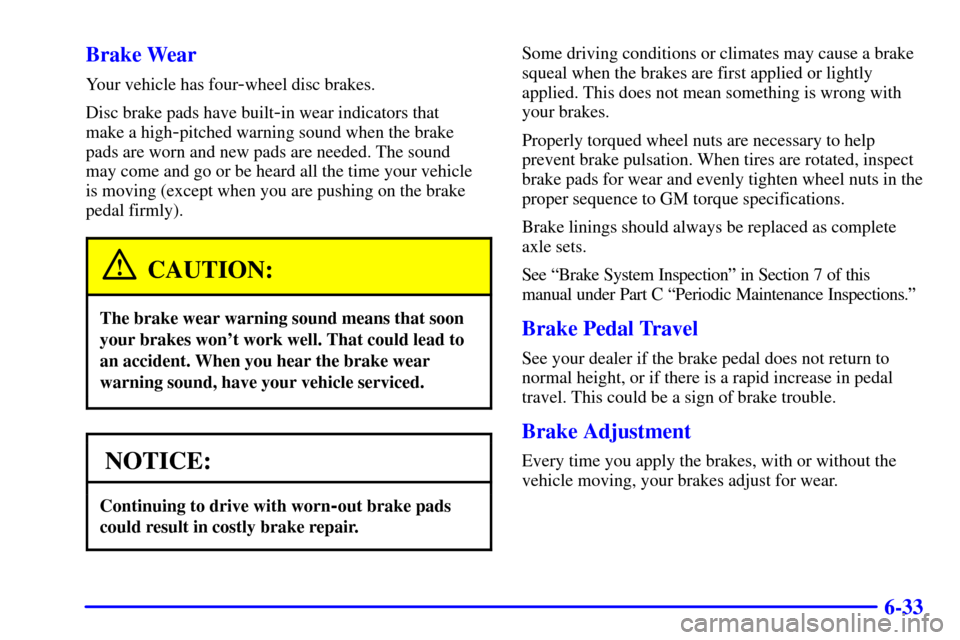Page 225 of 392

4-9
Remember: Anti-lock doesn't change the time you need
to get your foot up to the brake pedal or always decrease
stopping distance. If you get too close to the vehicle in
front of you, you won't have time to apply your brakes
if that vehicle suddenly slows or stops. Always leave
enough room up ahead to stop, even though you have
anti
-lock brakes.
Using Anti
-Lock
Don't pump the brakes. Just hold the brake pedal down
firmly and let anti
-lock work for you. You may feel a
slight brake pedal pulsation or notice some noise, but
this is normal.
Braking in Emergencies
At some time, nearly every driver gets into a situation
that requires hard braking.
If you have anti
-lock, you can steer and brake at the
same time. However, if you don't have anti
-lock, your
first reaction
-- to hit the brake pedal hard and hold it
down
-- may be the wrong thing to do. Your wheels
can stop rolling. Once they do, the vehicle can't respond
to your steering. Momentum will carry it in whatever
direction it was headed when the wheels stopped rolling.
That could be off the road, into the very thing you were
trying to avoid, or into traffic.If you don't have anti
-lock, use a ªsqueezeº braking
technique. This will give you maximum braking while
maintaining steering control. You do this by pushing on
the brake pedal with steadily increasing pressure.
In an emergency, you will probably want to squeeze the
brakes hard without locking the wheels. If you hear or
feel the wheels sliding, ease off the brake pedal. This
will help you retain steering control. If you do have
anti
-lock, it's different. See ªAnti-Lock Brakesº
in the Index.
In many emergencies, steering can help you more than
even the very best braking.
Traction Control System
(3800 V6 Engine)
Your vehicle is equipped with a Traction Control System
that limits wheel spin. This is especially useful in
slippery road conditions. The system operates only if it
senses that one or both of the front wheels are spinning
or beginning to lose traction. When this happens, the
system reduces engine power and may also upshift the
transaxle and apply the front brakes to limit wheel spin.
Page 235 of 392

4-19
Driving too fast through large water puddles or even
going through some car washes can cause problems, too.
The water may affect your brakes. Try to avoid puddles.
But if you can't, try to slow down before you hit them.
CAUTION:
Wet brakes can cause accidents. They won't work
as well in a quick stop and may cause pulling to
one side. You could lose control of the vehicle.
After driving through a large puddle of water or
a car wash, apply your brake pedal lightly until
your brakes work normally.
Hydroplaning
Hydroplaning is dangerous. So much water can build up
under your tires that they can actually ride on the water.
This can happen if the road is wet enough and you're
going fast enough. When your vehicle is hydroplaning,
it has little or no contact with the road.
Hydroplaning doesn't happen often. But it can if your
tires do not have much tread or if the pressure in one or
more is low. It can happen if a lot of water is standing on
the road. If you can see reflections from trees, telephone
poles or other vehicles, and raindrops ªdimpleº the
water's surface, there could be hydroplaning.
Hydroplaning usually happens at higher speeds. There
just isn't a hard and fast rule about hydroplaning.
The best advice is to slow down when it is raining.
Page 318 of 392

6-31
Brakes
Brake Fluid
Your brake master cylinder reservoir is on the driver's
side of the engine compartment. See ªEngine
Compartment Overviewº in the Index. It is filled
with DOT
-3 brake fluid.
There are only two reasons why the brake fluid level in
the reservoir might go down. The first is that the brake
fluid goes down to an acceptable level during normal
brake lining wear. When new linings are put in, the fluidlevel goes back up. The other reason is that fluid is
leaking out of the brake system. If it is, you should
have your brake system fixed, since a leak means that
sooner or later your brakes won't work well, or won't
work at all.
So, it isn't a good idea to ªtop offº your brake fluid.
Adding brake fluid won't correct a leak. If you add fluid
when your linings are worn, then you'll have too much
fluid when you get new brake linings. You should add
(or remove) brake fluid, as necessary, only when work is
done on the brake hydraulic system.
CAUTION:
If you have too much brake fluid, it can spill on
the engine. The fluid will burn if the engine is
hot enough. You or others could be burned,
and your vehicle could be damaged. Add brake
fluid only when work is done on the brake
hydraulic system.
When your brake fluid falls to a low level, your brake
warning light will come on. See ªBrake System Warning
Lightº in the Index.
Page 320 of 392

6-33 Brake Wear
Your vehicle has four-wheel disc brakes.
Disc brake pads have built
-in wear indicators that
make a high
-pitched warning sound when the brake
pads are worn and new pads are needed. The sound
may come and go or be heard all the time your vehicle
is moving (except when you are pushing on the brake
pedal firmly).
CAUTION:
The brake wear warning sound means that soon
your brakes won't work well. That could lead to
an accident. When you hear the brake wear
warning sound, have your vehicle serviced.
NOTICE:
Continuing to drive with worn-out brake pads
could result in costly brake repair.
Some driving conditions or climates may cause a brake
squeal when the brakes are first applied or lightly
applied. This does not mean something is wrong with
your brakes.
Properly torqued wheel nuts are necessary to help
prevent brake pulsation. When tires are rotated, inspect
brake pads for wear and evenly tighten wheel nuts in the
proper sequence to GM torque specifications.
Brake linings should always be replaced as complete
axle sets.
See ªBrake System Inspectionº in Section 7 of this
manual under Part C ªPeriodic Maintenance Inspections.º
Brake Pedal Travel
See your dealer if the brake pedal does not return to
normal height, or if there is a rapid increase in pedal
travel. This could be a sign of brake trouble.
Brake Adjustment
Every time you apply the brakes, with or without the
vehicle moving, your brakes adjust for wear.
Page 349 of 392

6-62
Circuit
BreakerDescription
RETAINED
ACCESSORY
PWR BRKRPower Window, Sunroof Breaker
Mini Fuses Description
PCM/BCM/
CLSTRPowertrain Control Module,
Body Control Module, Cluster
(Ignition 0)
WSW Windshield Wipers,
Windshield Washer
PCM (CRANK) Powertrain Control
Module (Crank)
CIG/AUX Accommodated
Device (Accessory)
BCM Body Control Module (Accessory)
SRS Supplemental Restraint System
ABS/PCM Anti
-Lock Brake System,
Powertrain Control Module, Brake
Switch, Crank Relay, Canister Vent
Solenoid (Run, Crank)Mini Fuses Description
STOP Brake Lamps, Body Control
Module (Run, Crank)
TURN SIGNAL Turn Signal Flashers
CRUISE Cruise Control Steering
Column Controls
A/C/CRUISE HVAC Temp Door Motors &
Module, Cruise Control Module
A/C FAN HVAC Blower
STR COL Steering Wheel Lighting
DR LK Body Control Module,
Door Lock Controls
PWR MIR Power Mirrors
CLSTR/BCM Cluster, Body Control Module,
Data Link Connector (Battery)
LH HTD
ST/BCMDriver's Heated Seat, Body
Control Module, Battery
Controlled Loads
Page 351 of 392
6-64
Circuit Breaker Description
POWER SEATS BRKR Power Seat Circuit Breaker
REAR DEFOG BRKR Rear Defog Breaker
Mini Fuses Description
RH HTD ST Passenger Heated Seat
PWR DROP Accommodated Device
B/U LP Back
-Up Lamps
DIC/RKE Driver Information
Center, Remote Keyless
Entry, HVAC
TRK/ROOF BRP Trunk Lamps,
Headliner Lamps
HVAC BLO HVAC Blower RelayMini Fuses Description
I/P BRP Instrument Panel Footwell
Lamps, Glovebox Lamps
HTD MIR Heated Mirrors
BRK SW Brake Switch
HAZ SW Hazard Switch
REAR PRK LP Rear Parking Lamps
AUX PWR Accessory Power
Outlet (Battery)
C/LTR Cigarette Lighter
RADIO Radio, Radio Amplifier
FRT PARK LP Front Parking Lamps,
Instrumentation Lighting